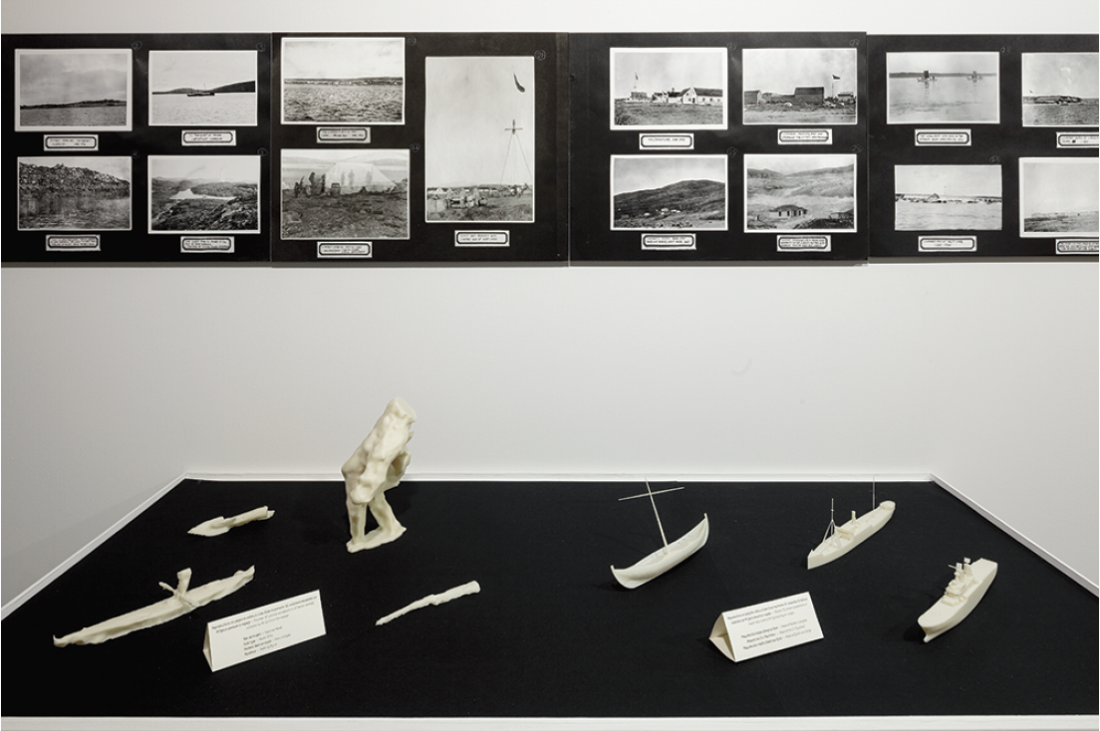“Sovereignty Landings”, and Trevor Paglen
The boundaries once set to mark territorial borders have been thoroughly reinforced, stacked taller and barb-wired to prevent foreign entry—or the possibility of escape. And while physical movement through space has been severely regulated, private space has been rendered a nearly antiquated concept, as our lives are increasingly laid bare before the gaze of an ever-attentive set of recording systems cataloguing our thoughts, behaviours and movements. This current situation is one that poses an inexhaustible set of questions when trying to decipher the sovereign subjects’ position within contemporary power relations. If the sovereign is the exceptional case—the one standing outside the limits of judicial law—what then does that exclusion allow us to perceive about our own laws and limits?

Dustin Wilson, installation view Excerpts from the album of the officer Quick, 2013, digital prints and a collection of polymer 3-D printed reproductions of Dorset carvings collected by Mr. Quick on the voyage. Photograph: Guy L’Heureux.
That SBC Gallery of Contemporary Art has proposed a “far-ranging inquiry into questions around the sovereign subject” as the point of reference for their ongoing programming provides a much needed opportunity for these conversations to be brought to the fore. I must admit to not having seen the first two installments: “Fault Lines” (Yael Bartana, Bertolt Brecht, François Bucher, Sophie Castonguay, Angela Melitopoulos & Maurizio Lazzarato) and “The Image Factory” (Harun Farocki and Hito Steyerl), both curated by gallery director Pip Day. Yet, in attending the latest two iterations a clear image of the program’s mandate is revealed.
The third exhibition in the series, “Landings,” includes a commissioned project by Dustin Wilson, alongside supporting works by Zacharias Kunuk and Peter Pitseolak & Joanasie Salamonie. Focused upon an interrogation of the narrative of the North, Wilson has exhibited a series of vitrines and photographs that conflate fact with fiction, calling into question the authority of the North’s historical authorship. Based on photographs from the McCord Museum’s collection of early documents of expeditions through the North, it is a project that echoes that of Janet Cardiff and George Bures Miller’s Road Trip (2004), in which the couple builds a narrative around a found set of slides. In “Landings,” Wilson uses image manipulation software to doctor these photographs so that they include identifiably invented creatures and events, fabricating through the use of a 3-D printer potential models for a new narrative every bit as likely to be an accurate account as our existing model. Their inclusion as relics from an unventured adventure further undermines the authority invested in the more “authentic” relics which have shaped our contemporary understanding of the North. As international media has again turned its attention to the resources vulnerable to disputes over northern sovereignty, there is perhaps no better time to re-examine who is writing this history and to ask if this authoring is anything more than a means to a subjectifying end.

Trevor Paglen, Canyon Hangars and Unidentified Vehicle; Tonopath test range, NV; distance– 18 miles, 12:45 p.m., 2006, chromogenic print, 76.2 x 91.44 cm. Courtesy the artist, Metro Pictures, New York; Altman Siegel, San Francisco and Galerie Thomas Zander, Cologne. Photograph: Guy L’Heureux.
Opening as a part of “Drone: The Automated Image” for this year’s Le Mois de la Photo à Montréal, the most recent sovereignty exhibition consists of a video and six photographs documenting Trevor Paglen’s ongoing “close” observation of military activity across the American southwest. The video, sourced from intercepted military drone communications, is primarily the bird’s-eye view of an undisclosed site over which flight data is streamed across the screen. There is a resounding sense of doom when you are confronted with this first-hand account of what can easily be read as the prelude to a targeting.
As the ubiquitous presence of military bases is examined the tone carries through the rest of the exhibition as an encroachment upon the expansive sublime landscape, which was once thought to define the free West. These technological sites now mar the landscape in plain view, yet they remain remote, classified and inaccessible. To capture them, Paglen is forced into the desert—out-of-range—setting up at distances as great as two miles from the bases. Because of this distancing an element of chance is introduced into what are otherwise highly deliberate works. An allowance for unpredictable environmental shifts must be accounted for, to the extent that each photograph becomes a record of previously unseen atmospheric information. In this haze, military technologies break down into their formal constituent parts and the landscape reasserts its hold upon the sublime.
The unmanned planes that populate Paglen’s work serve as agents of sovereignty, capable of seeing into other territories without leaving the safety of one’s own borders. Though these two exhibitions address sovereignty from relatively disparate points of origin, shared between them is a questioning of who is responsible for designating the sovereign subject and what are their criteria for doing so. Through this program of exhibitions, SBC proposes a space for a community to emerge, ready to engage in a conversation structured upon an investigation of the limits of sovereignty, with the aim of revealing just what does lie beyond those boundaries.
“Sovereignty: Landings” was exhibited at the SBC Gallery of Contemporary Art, Montreal, from May 23 to July 6, 2013. “Trevor Paglen” was exhibited at the SBC Gallery of Contemporary Art, Montreal, from September 7 to November 9, 2013.
Aryen Hoekstra is an artist currently based in Toronto.

